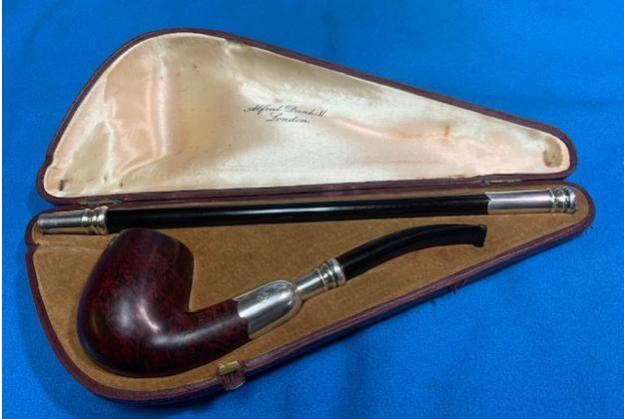Blog by Steve Laug
Time really flies during this COVID-19 time! It seems like just a few weeks ago I was contacted by an older gentleman about purchasing his pipe collection. He sent me the photos and I was amazed at what I saw. It had Dunhill pipes, BBB pipes, Orlik pipes, Barclay Rex Pipes, a couple of Meerschaums and a whole lot of other pipes. All I could say as I looked at the pipes was what a collection it was. We negotiated a deal and I think we both walked away quite happy with the exchange. But I have to tell you there was one pipe that took my breath away when I looked at pictures of it. It was a beautiful older cased Dunhill pipe that is shown in the photo below. I have worked on a lot of Dunhill pipes over the years and never had the opportunity to work on one like this. It would be a crown jewel of the Dunhill pipes that I have kept from the many I have worked on. From the photos it looked like the red leather case that housed it was in excellent condition. When the case was open it was lined with a cream coloured satin material on the top with Alfred Dunhill London embossed on the satin. The base of the case had more of a soft lining that was form fitted for the pipe and the shank extension. The pipe appeared to be in excellent condition from the photo he sent me. He said that the pipe was stamped on the left side and read Ao followed by Dunhill over London. On the right side it was stamped Made in England with a superscript underlined 2 after the D. Under that it was stamped Pat. America 1915 followed by the shape number 53. I could not wait to get it and have a look at it up close and personal. I had him ship it to Jeff for cleanup so it would be a while before I held in hand.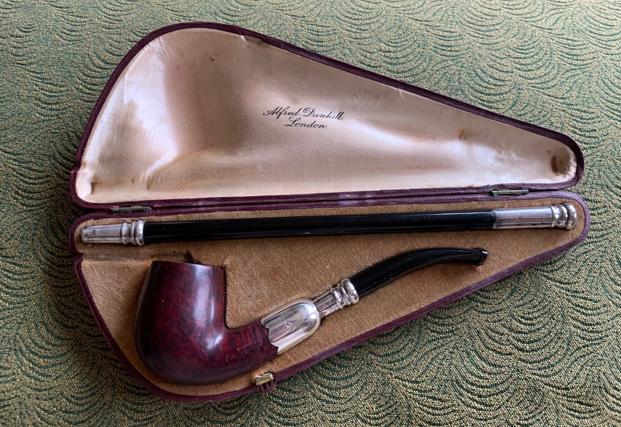 I posted the above picture of the pipe on the Vintage Dunhill Collectors Group on Facebook to see if the folks there could help learn about the pipe while I waited for its arrival. Several of the readers suggested I look on both Pipedia and Pipephil to help date the pipe and get a feel for its provenance. I figured I would do that so I turned to both sites and read the information contained in them (https://pipedia.org/wiki/Dunhill). One of the readers also sent me an intriguing link on Pipedia to a pipe that looked like the one I had purchased. I have attached the photo from that below. The photo below shows a 1920 Dunhill Cased Reading Pipe from the collection of the late Derek Green (https://pipedia.org/wiki/File:Dunhill_cased_reading_pipe_.jpg). It is very similar to the one that I was awaiting so it was a great link for me.
I posted the above picture of the pipe on the Vintage Dunhill Collectors Group on Facebook to see if the folks there could help learn about the pipe while I waited for its arrival. Several of the readers suggested I look on both Pipedia and Pipephil to help date the pipe and get a feel for its provenance. I figured I would do that so I turned to both sites and read the information contained in them (https://pipedia.org/wiki/Dunhill). One of the readers also sent me an intriguing link on Pipedia to a pipe that looked like the one I had purchased. I have attached the photo from that below. The photo below shows a 1920 Dunhill Cased Reading Pipe from the collection of the late Derek Green (https://pipedia.org/wiki/File:Dunhill_cased_reading_pipe_.jpg). It is very similar to the one that I was awaiting so it was a great link for me. The John Loring Collection also had a 1922 Dunhill Bruyere 53 Reading pipe that is identical to mine. I include that photo below. The stamping on the shank is identical to mine.
The John Loring Collection also had a 1922 Dunhill Bruyere 53 Reading pipe that is identical to mine. I include that photo below. The stamping on the shank is identical to mine. When the package arrived at Jeff’s place in Idaho he waited for me and opened the box with me on Facetime to look at the collection of pipes as he removed them from the box. It is an amazing collection and one that I am going to enjoy working on over the months ahead. Jeff took some photos of the Dunhill Cased Bruyere 53 Reading Pipe for me to look at while he worked his magic in cleaning up the pipe. It is a real beauty.
When the package arrived at Jeff’s place in Idaho he waited for me and opened the box with me on Facetime to look at the collection of pipes as he removed them from the box. It is an amazing collection and one that I am going to enjoy working on over the months ahead. Jeff took some photos of the Dunhill Cased Bruyere 53 Reading Pipe for me to look at while he worked his magic in cleaning up the pipe. It is a real beauty. 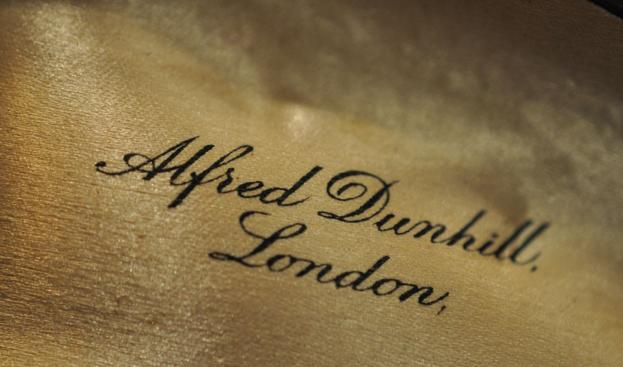
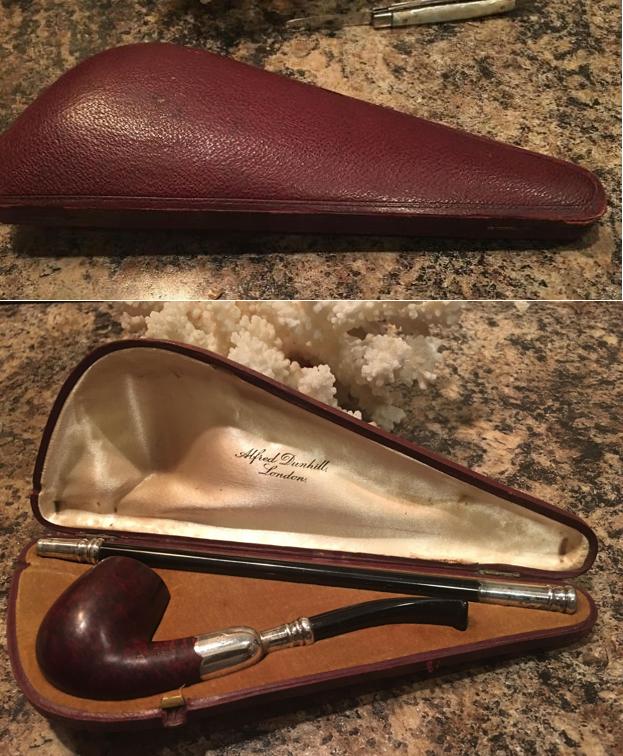
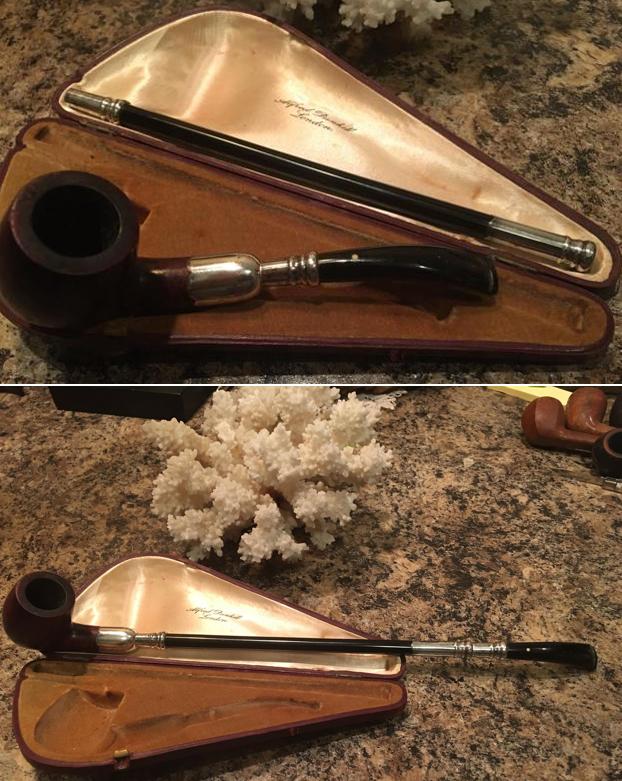 The stamping on the pipe was exactly as noted above. I am including the details that I see in the photos below. It was stamped on the left side Ao followed by DUNHILL (over) LONDON. The Ao stamp is the designation for a Bruyere finish on a pipe. The Dunhill over London (equally aligned) with the Made in England designation on the right side date the pipe to 1920-1922 according to John Loring’s, The Dunhill Briar Pipe book, page 11. The silver ferrule on the left had a AD in a diamond.
The stamping on the pipe was exactly as noted above. I am including the details that I see in the photos below. It was stamped on the left side Ao followed by DUNHILL (over) LONDON. The Ao stamp is the designation for a Bruyere finish on a pipe. The Dunhill over London (equally aligned) with the Made in England designation on the right side date the pipe to 1920-1922 according to John Loring’s, The Dunhill Briar Pipe book, page 11. The silver ferrule on the left had a AD in a diamond.
On the right side it was stamped MADE IN ENGLAND2 with a superscript underlined 2 after the D that further pins the date down to 1922 (1920 + 2 is the formula). Loring states on page 16 “ a pipe with “D” with tails (first letter of Dunhill) and either no date code (most commonly found) dates to 1921. A pipe with a 2 with or without a “D” with tails dates to 1922.” Underneath that it was stamped Pat. America 1915 which I did not understand until I read Loring’s book (Page 12) where he says “Inner tube patent numbers or references also serve to denote the earliest the pipe could have been manufactured, e.g. an English patent reference (PAT No 5861/12) would not have been stamped prior to the 1913 patent grant, nor a Canadian patent reference (PATENTED 1914) prior to the 1914 grant, nor a US patent reference (PATENTED MARCH.9.15 or PAT. AMERICA 1915) prior to the 1915 grant.” Now I knew what I was dealing with concerning the PAT.AMERICA 1915 stamp. The number 53 following the stamping was the shape number for a bent billiard (https://rebornpipes.com/2012/11/01/dunhill-pipe-shapes-collated-by-eric-w-boehm/). 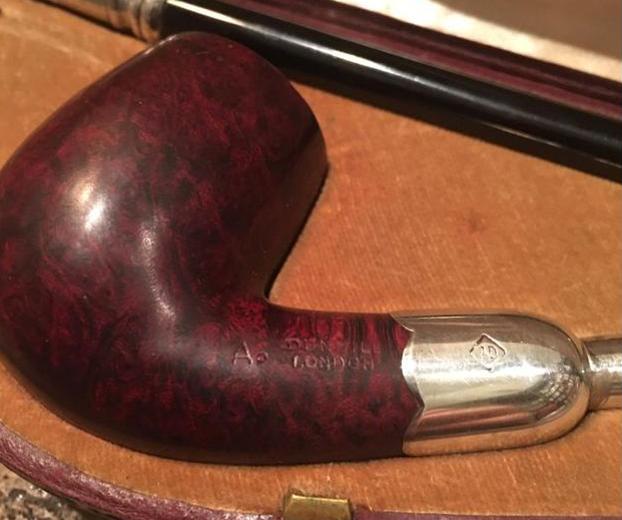
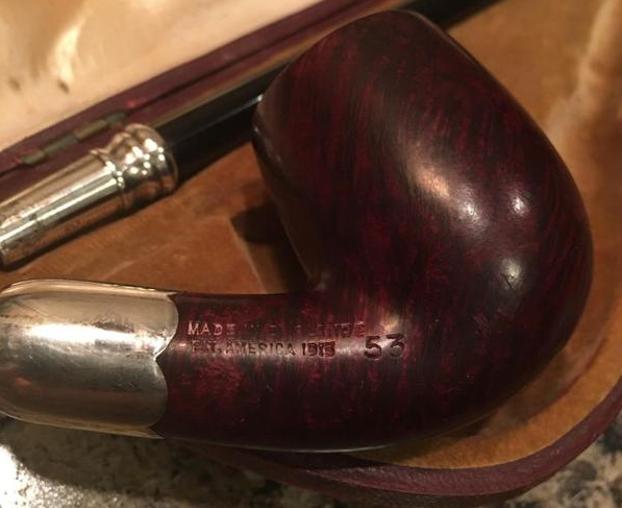 Jeff removed this beauty from the case and took photos of it in various configurations and from different angles. It is quite stunning even with the tarnish on the silver. It is going to cleanup really well.
Jeff removed this beauty from the case and took photos of it in various configurations and from different angles. It is quite stunning even with the tarnish on the silver. It is going to cleanup really well.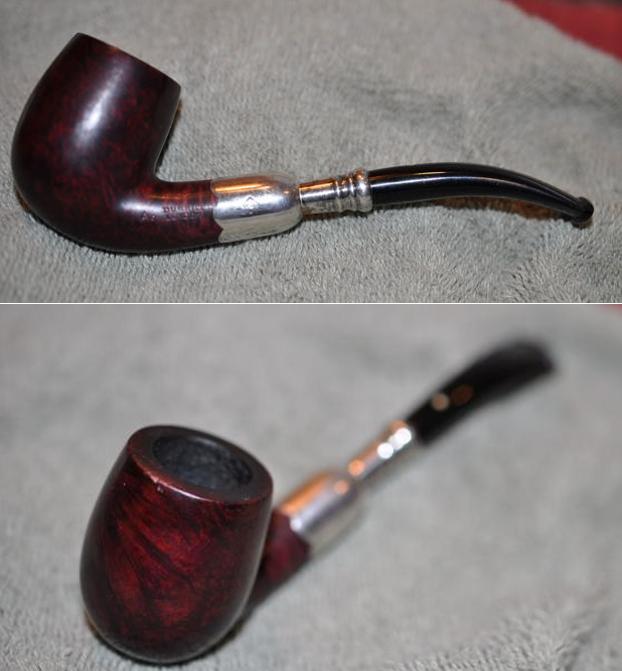
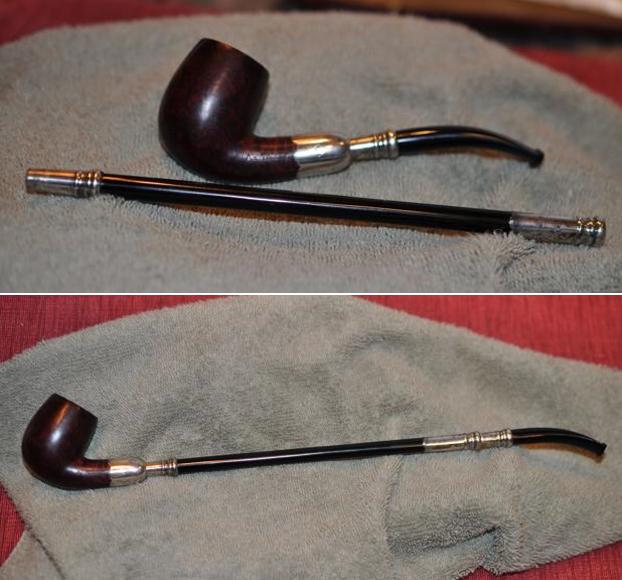 Jeff took photos of the bowl and rim top to show the cake in the bowl. The smooth rim top showed some darkening and damage as did the inner and outer edges of the bowl. He took photos of the top and underside of the stem showing the tooth chatter, scratching and oxidation on the stem surface and wear on the edges of the button.
Jeff took photos of the bowl and rim top to show the cake in the bowl. The smooth rim top showed some darkening and damage as did the inner and outer edges of the bowl. He took photos of the top and underside of the stem showing the tooth chatter, scratching and oxidation on the stem surface and wear on the edges of the button. 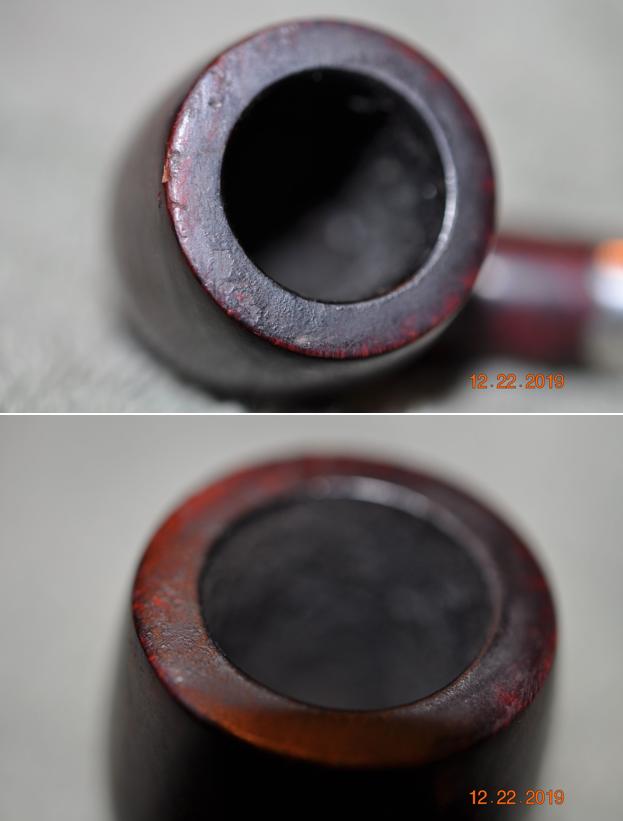
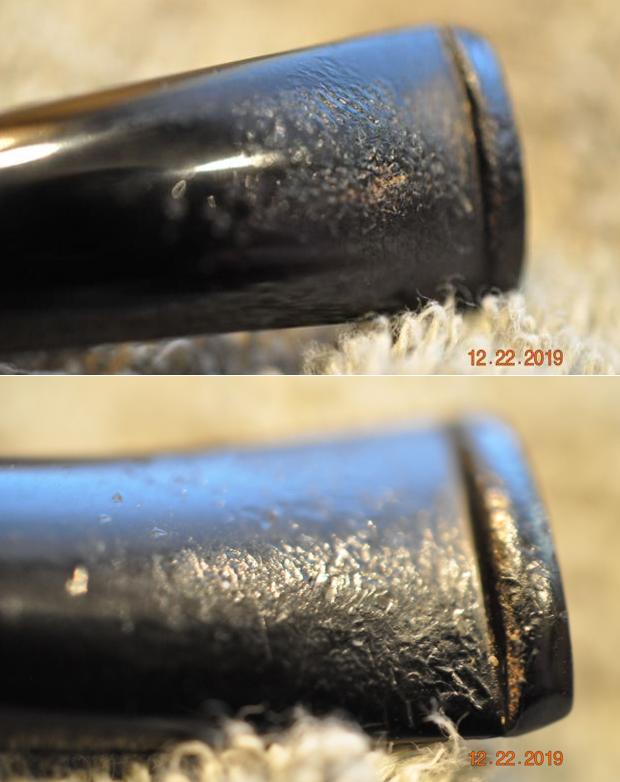 Jeff took photos of the sides and heel of the bowl to show the condition of the finish. You can see the beautiful grain even through the dirt and debris of almost 100 years.
Jeff took photos of the sides and heel of the bowl to show the condition of the finish. You can see the beautiful grain even through the dirt and debris of almost 100 years. 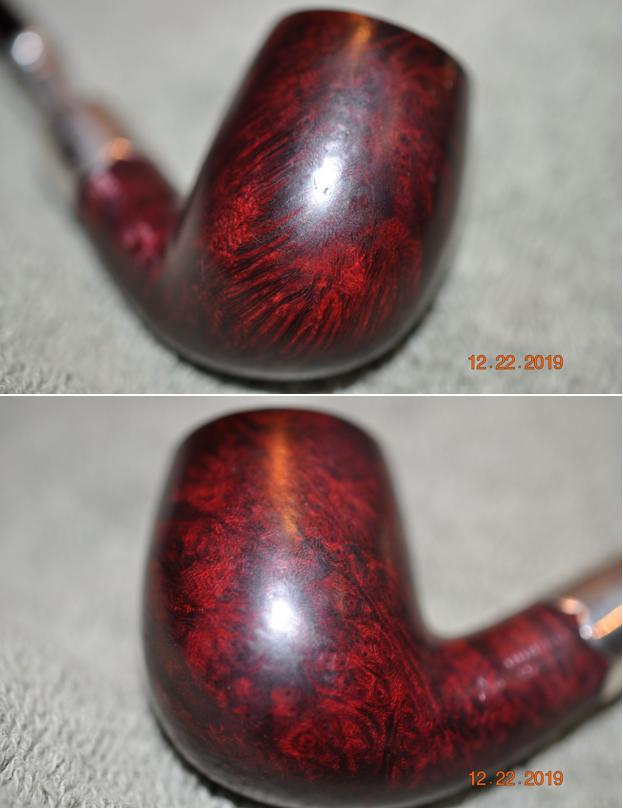
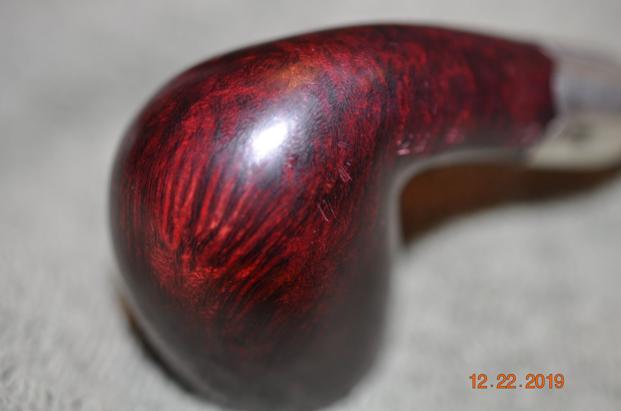 The stamping is clear and readable as noted above. The marks on the silver are also clear and readable on the ferrule. The turned silver cap on the end of the military bit stem is also quite beautiful.
The stamping is clear and readable as noted above. The marks on the silver are also clear and readable on the ferrule. The turned silver cap on the end of the military bit stem is also quite beautiful.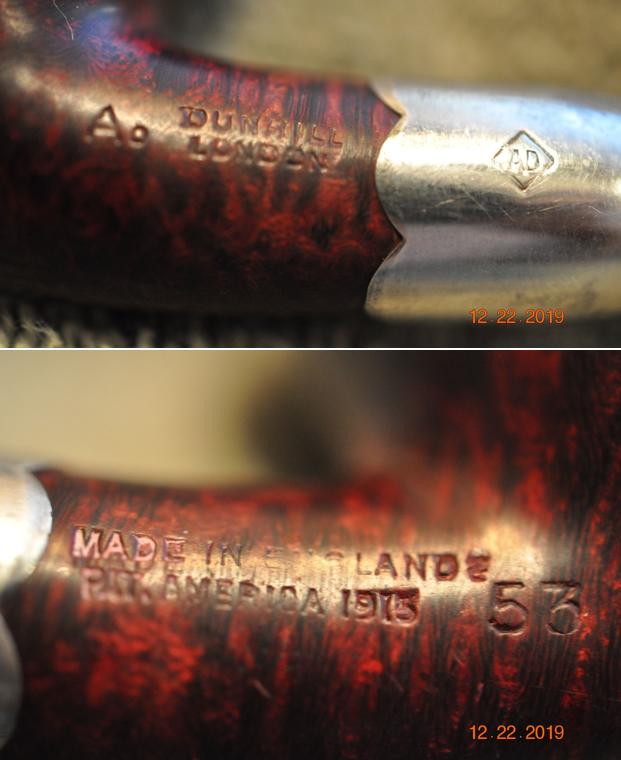
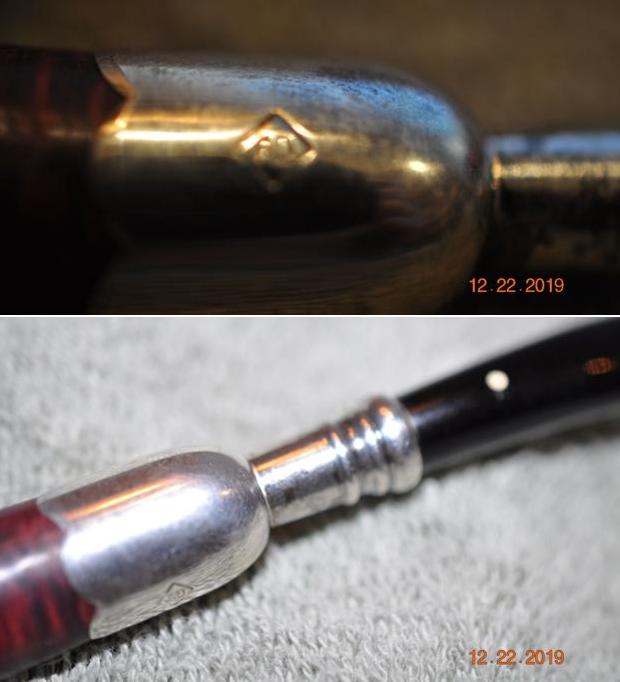
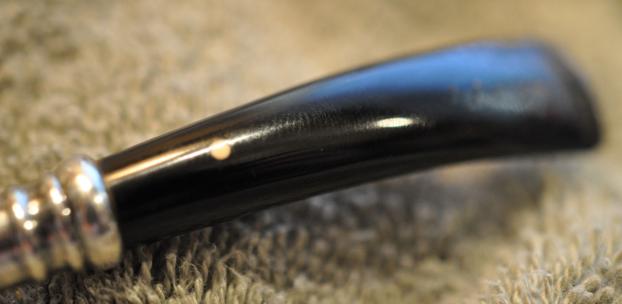 With the information from the two sites and John Loring’s book I had a pretty clear idea on the background of the pipe. It was definitely an old timer and really was a once in a life time find. Now it was time to work on the pipe.
With the information from the two sites and John Loring’s book I had a pretty clear idea on the background of the pipe. It was definitely an old timer and really was a once in a life time find. Now it was time to work on the pipe.
Jeff carefully cleaned the pipe from top to stern. He reamed it with a PipNet pipe reamer and cleaned up the reaming with a Savinelli Fitsall Pipe Knife. He scrubbed out the internals of the shank, stem and shank extension with alcohol, pipe cleaners and cotton swabs until the pipe was clean. He scrubbed the exterior of the bowl with Murphy’s Oil Soap and a tooth brush to remove the grime and grit on the briar and the lava on the rim top. The finish looks much better and has a deep richness in the colour that highlights some great grain. The rim top looked very good and the inner and outer edge looked very good. The nicks on the outer edge lifted with the scrubbing. Jeff scrubbed the stem with Before & After Deoxidizer to remove the oxidation on the rubber. He worked it over with Soft Scrub All Purpose Cleaner to remove any remnants of oxidation. When the pipe arrived here in Vancouver for the second stop of its restoration tour I was amazed it looked so good. Here are some photos of what I saw. 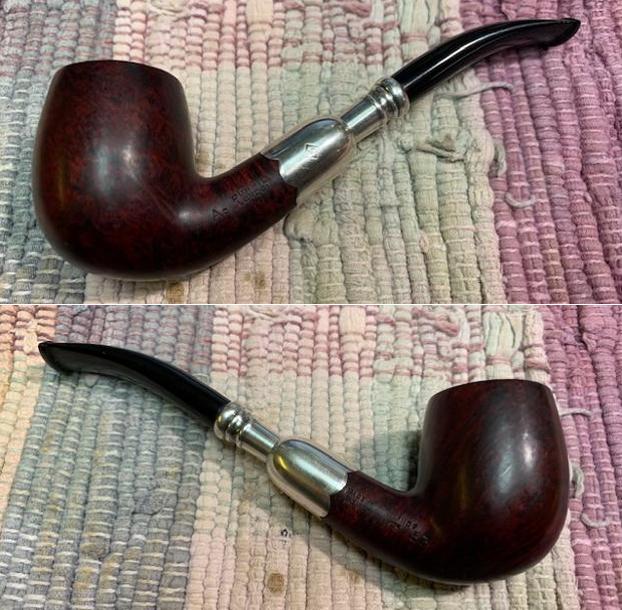
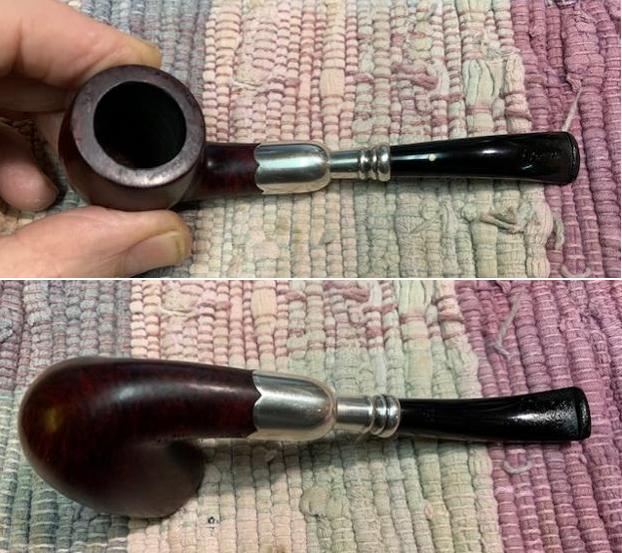 I took some close up photos of the rim top and the stem surface. The rim top looked good. There were some spots on the surface and some scratches. The inner edge has some rough spots but it was okay for now. I took close up photos of the stem to show the condition of the surface and button.
I took some close up photos of the rim top and the stem surface. The rim top looked good. There were some spots on the surface and some scratches. The inner edge has some rough spots but it was okay for now. I took close up photos of the stem to show the condition of the surface and button. 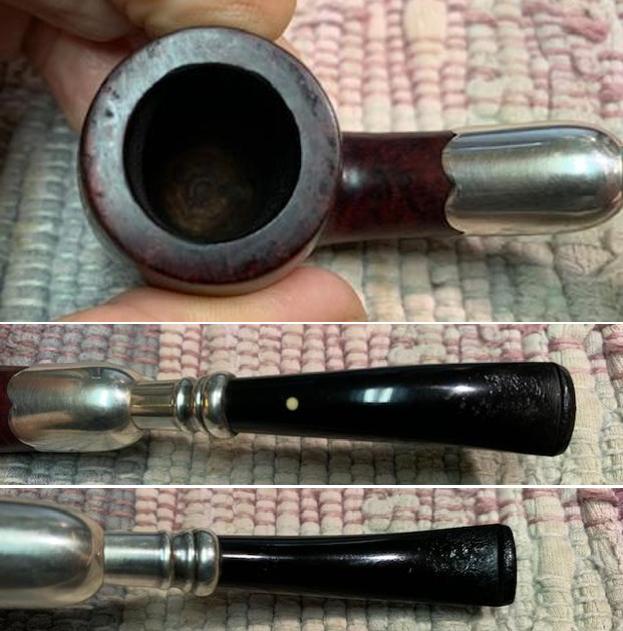 I took the pipe apart and took a photo of the pipe with the short stem and with the extension. It is a good looking pipe and very unique.
I took the pipe apart and took a photo of the pipe with the short stem and with the extension. It is a good looking pipe and very unique.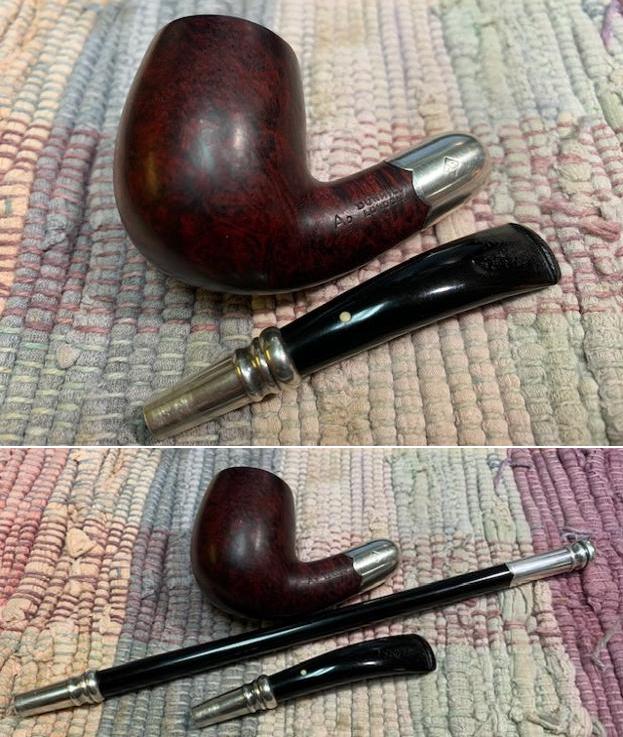 I polished the smooth rim top and edges with micromesh sanding pads – dry sanding it with 1500-12000 grit pads. After each pad I wiped the briar down with a damp cloth. I was able to remove the damage on the top and edges.
I polished the smooth rim top and edges with micromesh sanding pads – dry sanding it with 1500-12000 grit pads. After each pad I wiped the briar down with a damp cloth. I was able to remove the damage on the top and edges. 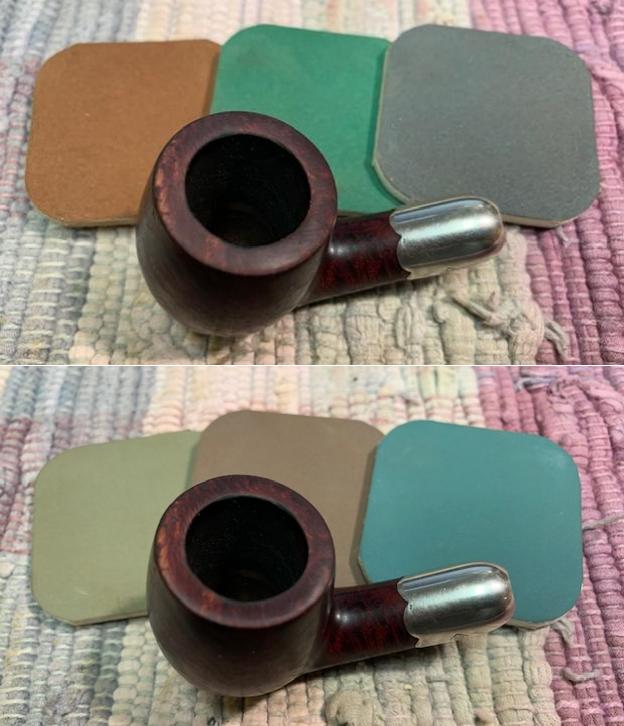
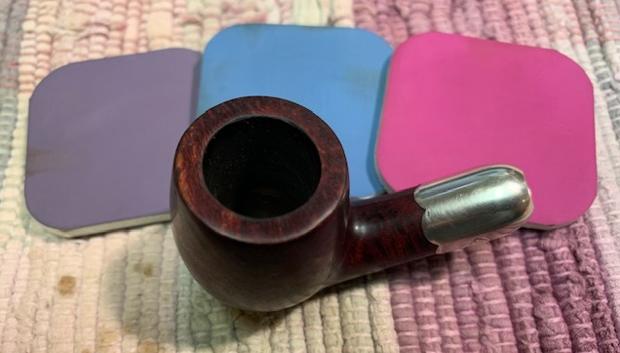 I worked some Before & After Restoration Balm into the surface of the briar with my fingertips to clean, enliven and protect the briar. I let the balm sit for 15 minutes and then buffed with a cotton cloth to raise the shine. The photos show the bowl at this point in the restoration process.
I worked some Before & After Restoration Balm into the surface of the briar with my fingertips to clean, enliven and protect the briar. I let the balm sit for 15 minutes and then buffed with a cotton cloth to raise the shine. The photos show the bowl at this point in the restoration process.

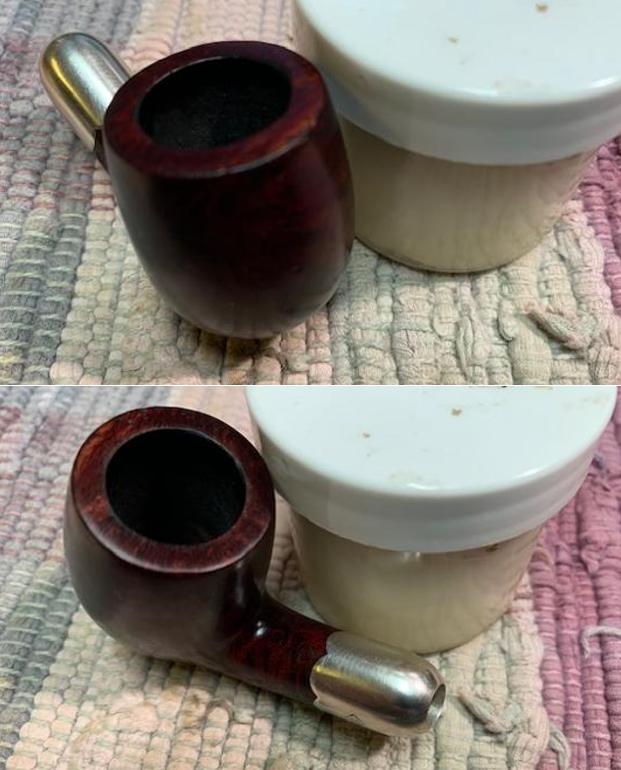 I polished the scalloped silver ferrule with a jewelers cloth to remove any residual tarnish and also to protect it from future tarnish (at least for awhile). The interesting detail for me is that the ferrule is scallop and the end of the shank extension that holds the stem also is scalloped.
I polished the scalloped silver ferrule with a jewelers cloth to remove any residual tarnish and also to protect it from future tarnish (at least for awhile). The interesting detail for me is that the ferrule is scallop and the end of the shank extension that holds the stem also is scalloped.
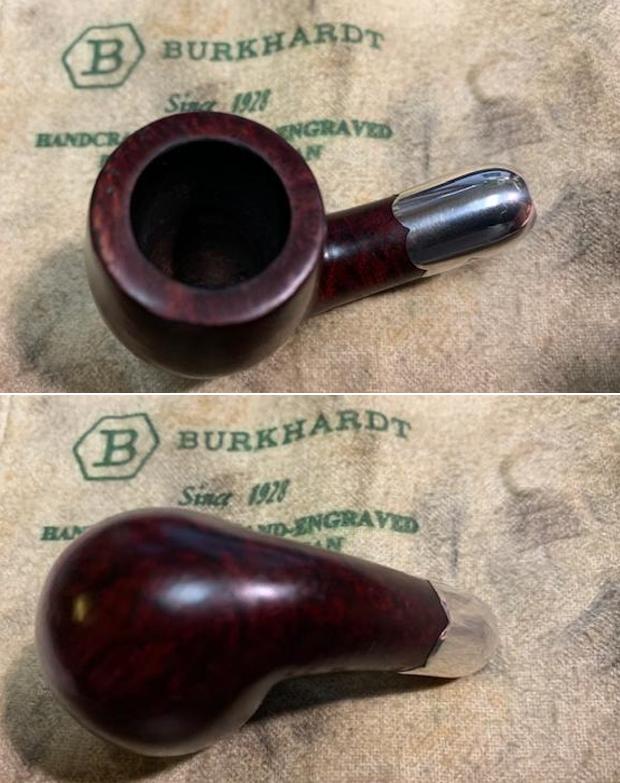 With that done the bowl was finished other than the final buffing. I set it aside and turned my attention to the stem. I sanded out the tooth marks and chatter on the stem with 220 grit sandpaper. I started the polishing with 400 grit wet dry sandpaper.
With that done the bowl was finished other than the final buffing. I set it aside and turned my attention to the stem. I sanded out the tooth marks and chatter on the stem with 220 grit sandpaper. I started the polishing with 400 grit wet dry sandpaper. 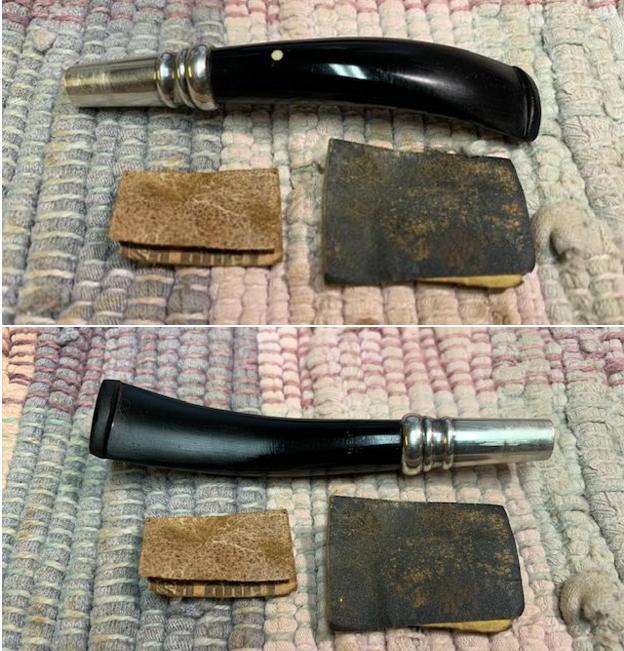 I polished the silver stem cap with a jewelers cloth that helps remove any residual tarnish and protects the silver.
I polished the silver stem cap with a jewelers cloth that helps remove any residual tarnish and protects the silver.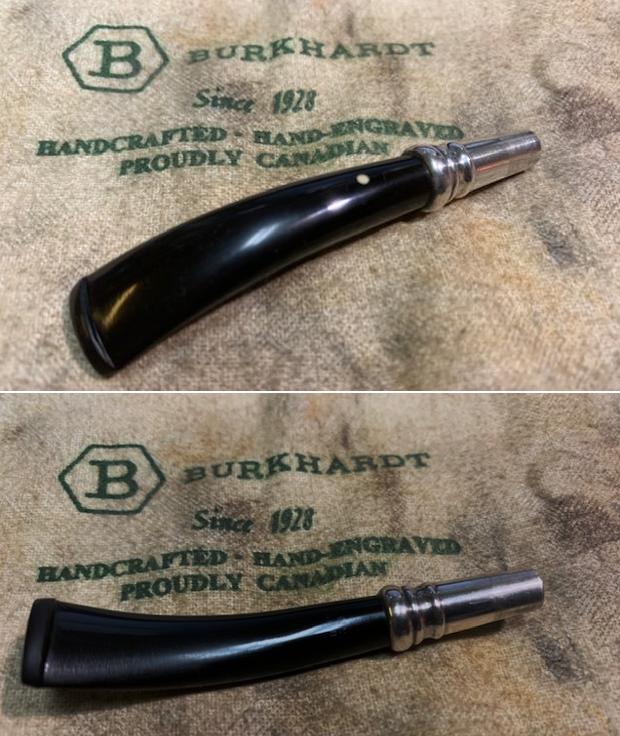 I polished the stem with micromesh sanding pads – wet sanding with 1500-12000 grit sanding pads. I wiped it down after each sanding pad with Obsidian Oil. I polished it with Before & After Pipe Stem Polish – both Fine and Extra Fine.
I polished the stem with micromesh sanding pads – wet sanding with 1500-12000 grit sanding pads. I wiped it down after each sanding pad with Obsidian Oil. I polished it with Before & After Pipe Stem Polish – both Fine and Extra Fine.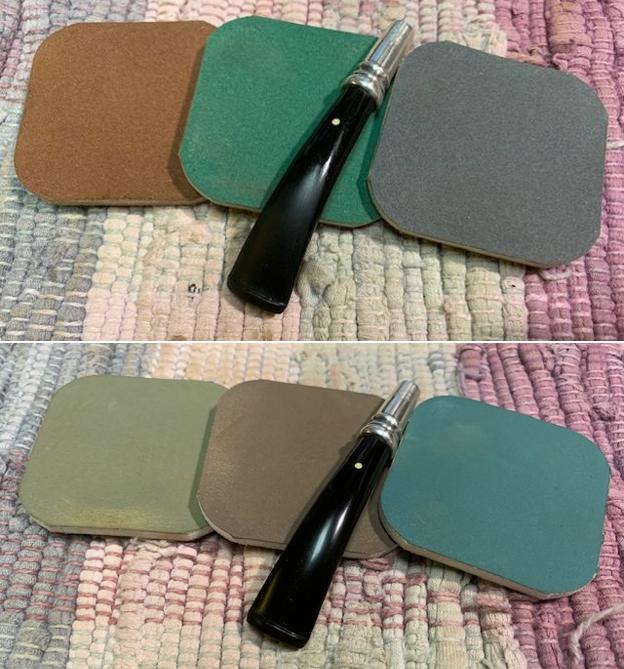
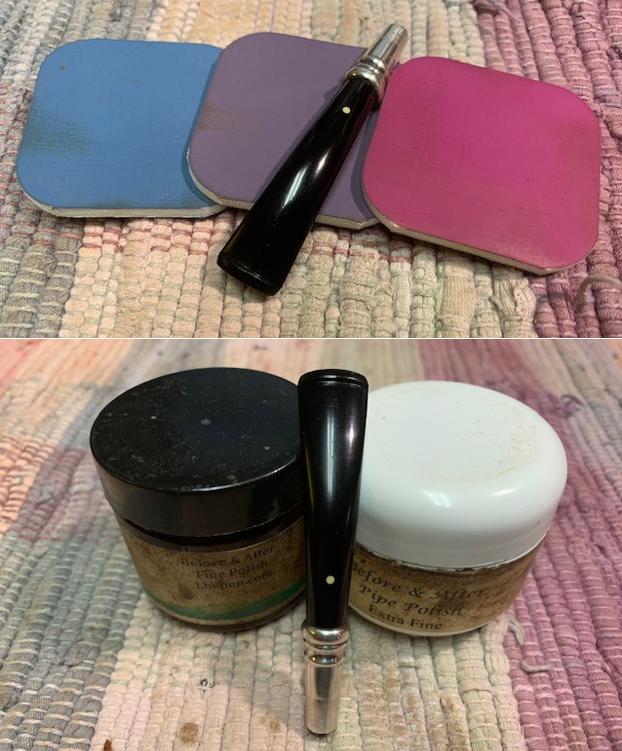 With the bowl and the short stem finished I put the pipe back together and buffed it on the wheel using Blue Diamond to give it a shine. I gave the bowl and stem multiple coats of carnauba wax on the wheel and then buffed it with a clean buffing pad to raise the shine. I hand buffed it with a microfiber cloth to deepen the shine. It really is an amazing little pipe. The dimensions of this part of the pipe are – Length: 5 inches, Height: 1 ¾ inches, Outside diameter of the bowl: 1 ¼ inches, Chamber diameter: ¾ of an inch. The weight of the short version of the pipe is 1.13 ounces/32 grams. This once is a lifetime find – a 1922 Cased Dunhill Bruyere 53 Reading Pipe is joining the other pipes in my collection of Dunhills and will hold a place of honour while it is in my trust. One day soon I will enjoy a special bowl of tobacco in it and be transported to a slower paced time in history where I can enjoy a respite.
With the bowl and the short stem finished I put the pipe back together and buffed it on the wheel using Blue Diamond to give it a shine. I gave the bowl and stem multiple coats of carnauba wax on the wheel and then buffed it with a clean buffing pad to raise the shine. I hand buffed it with a microfiber cloth to deepen the shine. It really is an amazing little pipe. The dimensions of this part of the pipe are – Length: 5 inches, Height: 1 ¾ inches, Outside diameter of the bowl: 1 ¼ inches, Chamber diameter: ¾ of an inch. The weight of the short version of the pipe is 1.13 ounces/32 grams. This once is a lifetime find – a 1922 Cased Dunhill Bruyere 53 Reading Pipe is joining the other pipes in my collection of Dunhills and will hold a place of honour while it is in my trust. One day soon I will enjoy a special bowl of tobacco in it and be transported to a slower paced time in history where I can enjoy a respite. 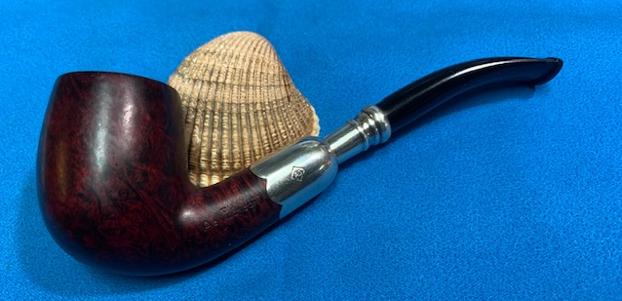
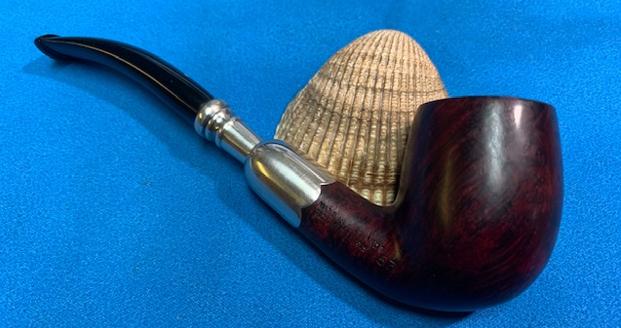

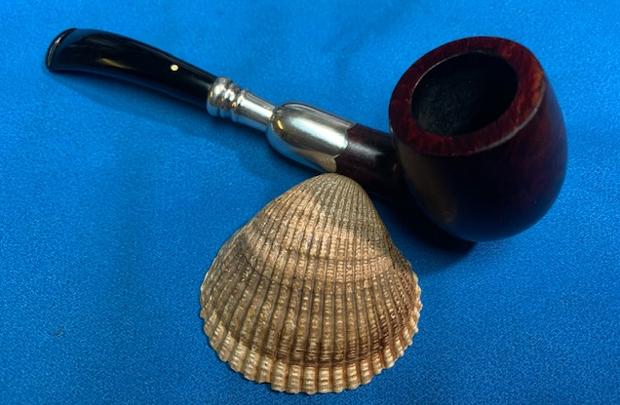
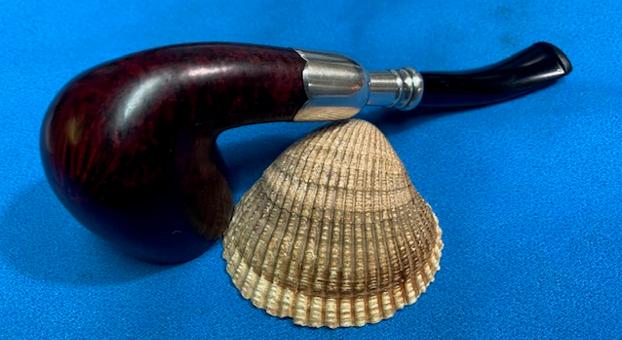

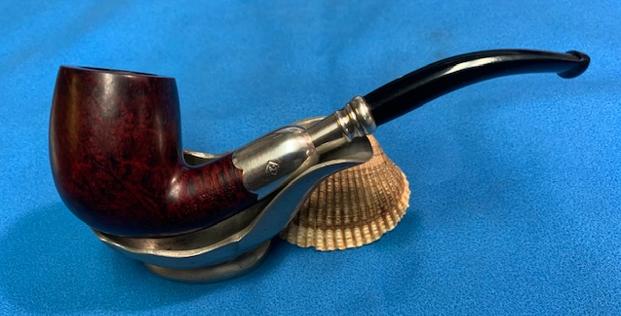
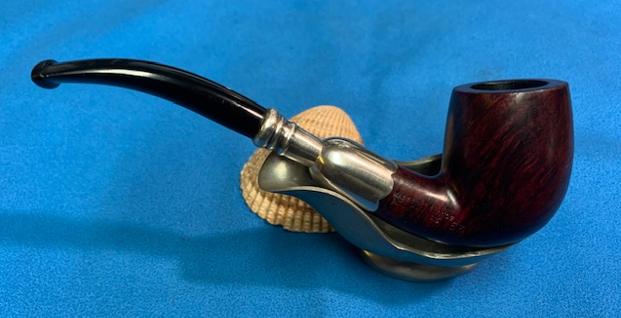
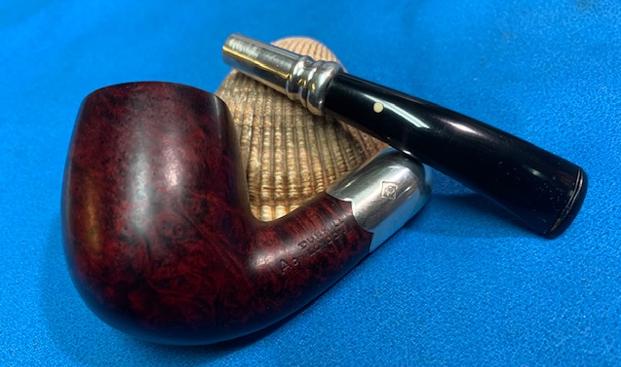
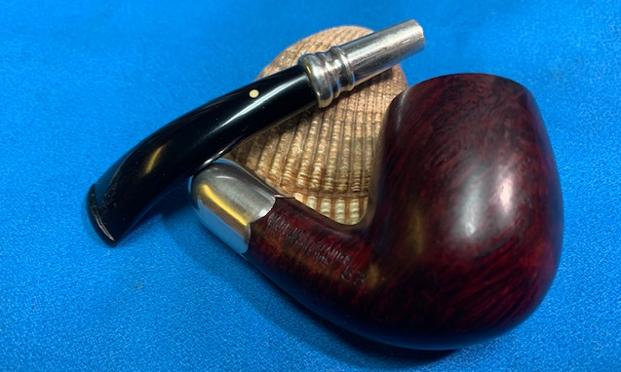
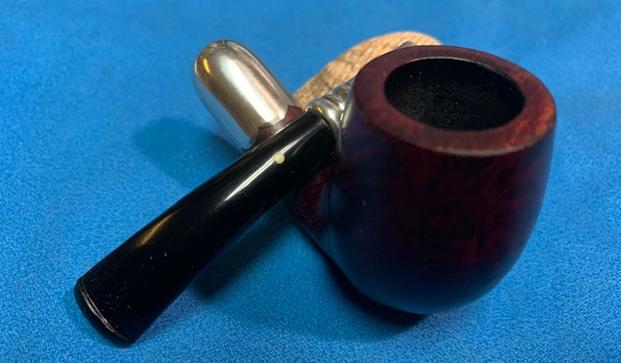
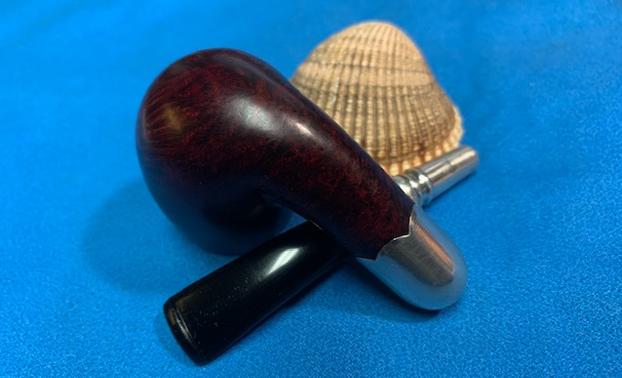
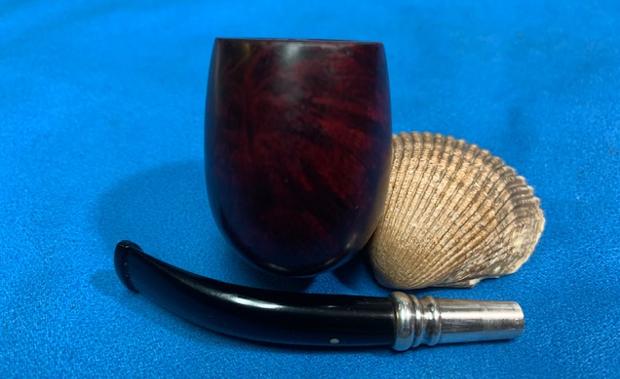
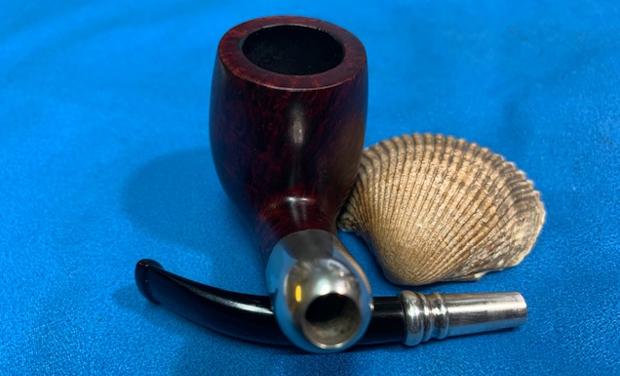 With the pipe and short stem finished all that remained was to finish the shank extension that fit in the shank end of the pipe. The end that fit into the shank had the same end cap as the stem itself. The opposite end was fitted to receive the end cap of the stem. The tube between the caps appears to be hard rubber but I am not certain. Some of the pipes of this time period used albatross wing bones for the extension but this is not bone. I polished it with a jewelers cloth to remove residual tarnish in the turnings of the silver caps and polished the shank extension with Obsidian Oil.
With the pipe and short stem finished all that remained was to finish the shank extension that fit in the shank end of the pipe. The end that fit into the shank had the same end cap as the stem itself. The opposite end was fitted to receive the end cap of the stem. The tube between the caps appears to be hard rubber but I am not certain. Some of the pipes of this time period used albatross wing bones for the extension but this is not bone. I polished it with a jewelers cloth to remove residual tarnish in the turnings of the silver caps and polished the shank extension with Obsidian Oil. The extension tube itself is 7 ½ inches long. I took a few photos of the pipe next to the extension to give a sense of the size. I also took photos of the extension tube with the stem in place to show the look of it. Finally the last photos give a sense of the fully extended Bruyere Reading Pipe. With it installed on the pipe the length of the pipe is 12 inches. Height and other measurements remain as noted above.
The extension tube itself is 7 ½ inches long. I took a few photos of the pipe next to the extension to give a sense of the size. I also took photos of the extension tube with the stem in place to show the look of it. Finally the last photos give a sense of the fully extended Bruyere Reading Pipe. With it installed on the pipe the length of the pipe is 12 inches. Height and other measurements remain as noted above.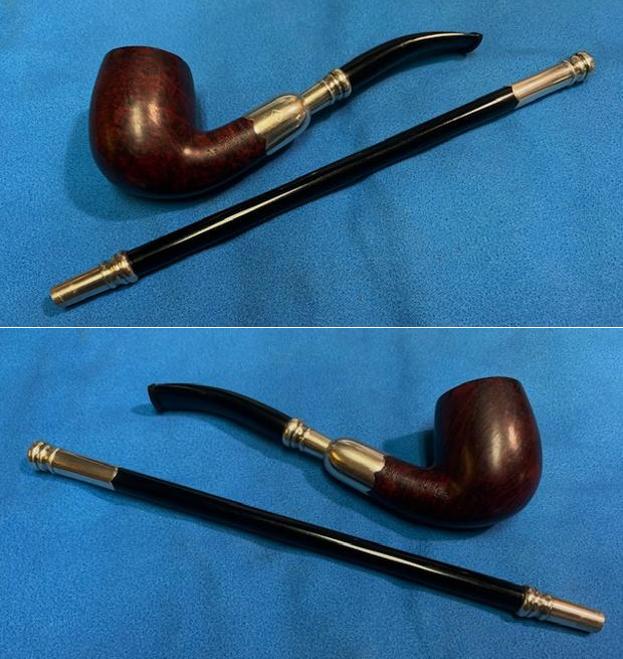
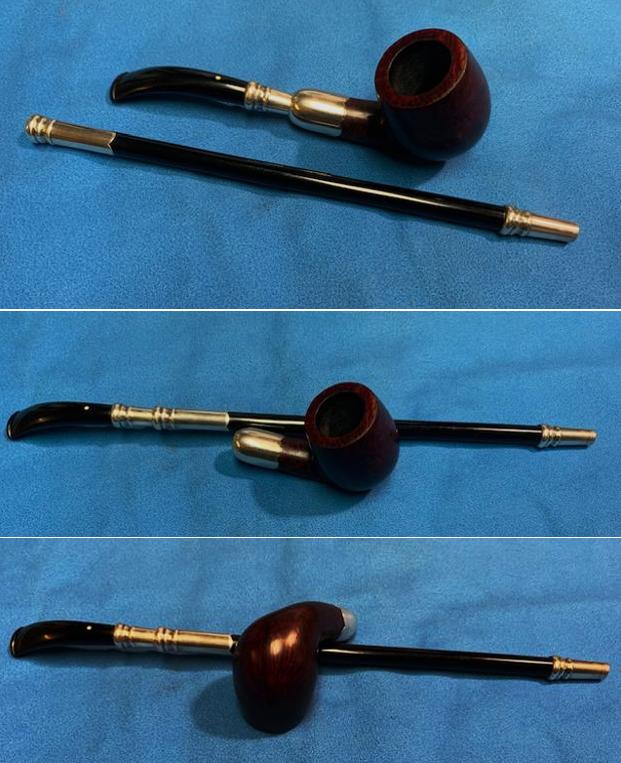
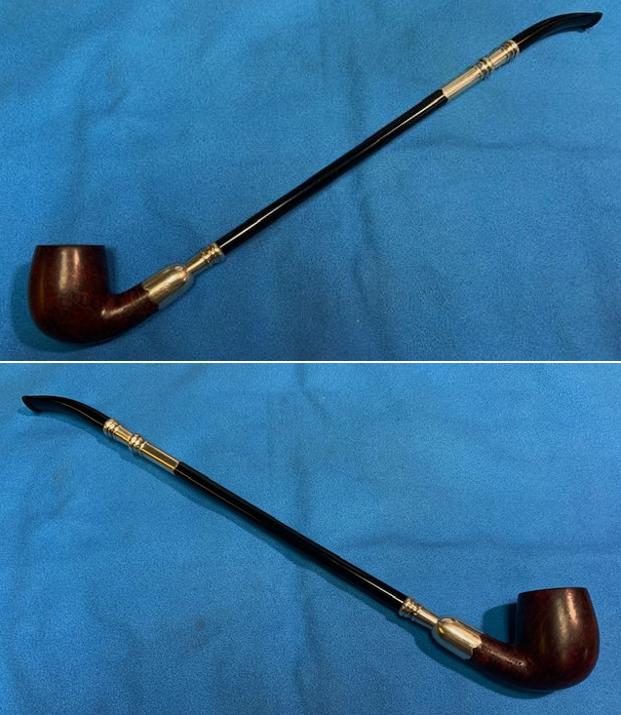
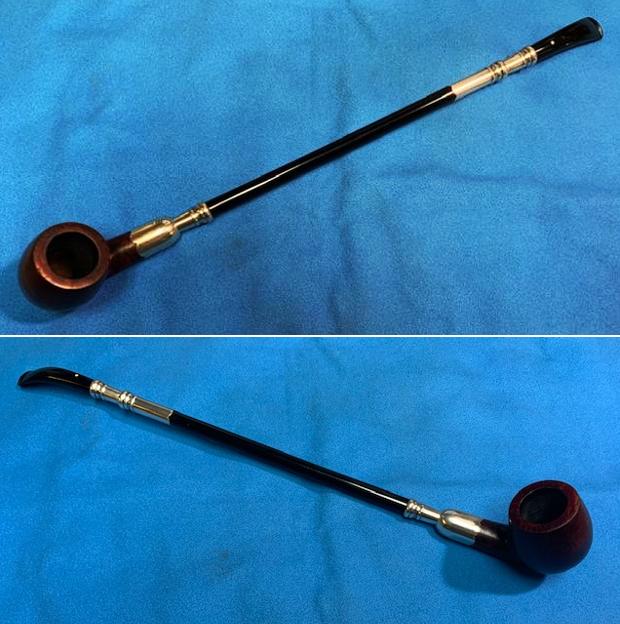
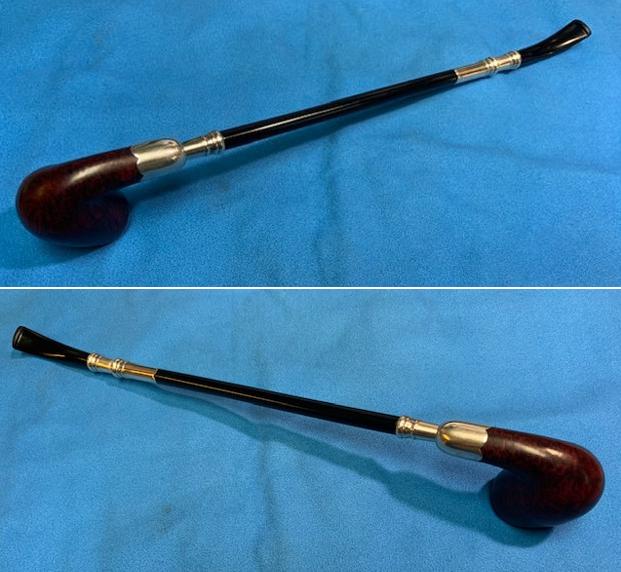 With the pipe finished I took it apart and put it carefully back in its case. The day will come (soon I hope) that I will take it out and smoke a bowl of some aged Virginia and enjoy the coolness of the smoke as I read a book on my front porch. Thanks for walking through the restoration with me on this beautiful piece of Dunhill Pipe Crafting History.
With the pipe finished I took it apart and put it carefully back in its case. The day will come (soon I hope) that I will take it out and smoke a bowl of some aged Virginia and enjoy the coolness of the smoke as I read a book on my front porch. Thanks for walking through the restoration with me on this beautiful piece of Dunhill Pipe Crafting History. 

